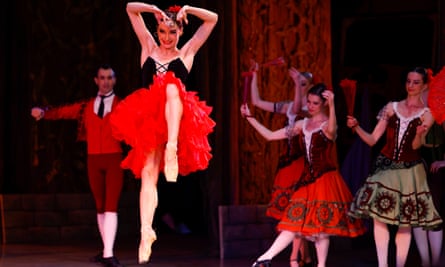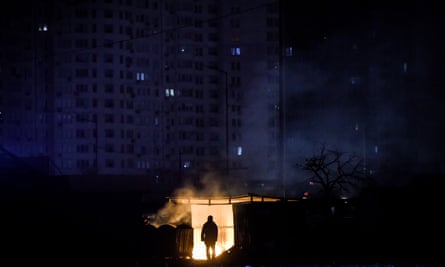Every week we wrap up the must-reads from our coverage of the Ukraine war, from news and features to analysis and opinion.
A bloody morass in Bakhmut

Fighting around the key eastern Ukraine town of Bakhmut descended into a bloody morass with hundreds of dead and injured reported daily, Peter Beaumont reported, as neither Russian or Ukrainian forces are able to make a significant breakthrough after months of fighting.
As Russia moved fresh formations to the area in recent weeks, including reinforcements previously in the Kherson region, the fighting in the Bakhmut sector has turned into trench warfare reminiscent of the first world war.
Over the weekend, images emerged of Ukrainian soldiers in flooded, muddy trenches and battlefields dotted with the stumps of trees cut down by withering artillery barrages.
The Ukrainian artists taking on Putin’s Russia

Where to begin a story of war, Charlotte Higgins asked in her feature on Ukrainian artists this week. Every war teems with stories: of survival and violence, of resistance and compliance, of struggle and terror. They go together; many of the oldest stories that survive (the Iliad, the Odyssey) are stories of war and its aftermath. The Russian invasion of Ukraine is a war full of stories but also a war about a story, about the accepted facts, about the prevailing narrative. Vladimir Putin’s “special operation”, as he calls it, seems to have been intended to provide a spectacle, a kind of war movie, for domestic consumption, drawing Russians together against what he hoped to frame as a common enemy – described variously as Nazis, terrorists or even, bizarrely, as the forces of Satan.
At the same time, the war’s false justification has its own disturbing narrative, its own warped internal logic. Underlying Putin’s military aggression, as his speeches and essays have for years made clear, is his assertion that Ukraine has no distinct existence – that it can be seen only as an adjunct to Russia. In such a war on a nation’s culture, identity and history, it is artists and cultural figures who find themselves the crack troops of the resistance. The war is on one level about borders, and it is being fought with shells, Himars rocket launchers and Shahed-136 drones. But it is, on a deeper level, about culture. And, desperately holding the line, fighting on the cultural front, weaponising their work, are Ukraine’s artists.
Fears for all Ukraine’s nuclear plants after emergency shutdowns
There are growing fears that Russia’s relentless targeting of Ukraine’s electricity grid will threaten the safety of the country’s nuclear power plants, in the wake of an unprecedented emergency shutdown on Wednesday, Julian Borger reported.
Petro Kotin, the president of Ukraine’s nuclear power company, Energoatom, said that all safety mechanisms had worked as intended on Wednesday, but two generators were damaged in the process, delaying the restart of two reactors. Kotin said repeated shutdowns caused by more Russian missile attacks could cause extensive damage, with a potentially severe impact on Ukraine’s power supply and possibly on nuclear safety.
‘Russia wins by losing’
Yale historian Timothy Snyder, who leads a crowdfunding campaign to raise $1.25m to fund an anti-drone system to detect enemy devices and jam signals, told Jennifer Rankin that it would be good for world peace if Russia lost the war.
“Russia wins by losing. Russia really needs to lose this war, and to lose it decisively,” he said. “The whole colonial move towards Ukraine is a distraction, a substitute for the internal changes which Russia really has to make.
“What European history really shows, and quite powerfully, is that in order to become, quote unquote, a ‘normal’ European country, you have to become post-imperial, [meaning] you have to lose your wars.”
For this reason, he thinks meaningful negotiations can only take place once Ukraine has won the war. Russians are already signalling that negotiations are only a means “to regroup and attack again. And so I think we should probably listen to them when they say that.”

Letter bombs in Spain
Spain has ordered increased security at government buildings and embassies after the discovery of six letter bombs and incendiary devices over the past seven days, Sam Jones reported, including one that exploded at Ukraine’s embassy in Madrid on Wednesday and another that was detected at the US embassy on Thursday.
Devices have also been sent to the prime minister, the defence ministry, an arms company that makes rocket launchers donated to Kyiv, and a military airbase near the Spanish capital.
Spain’s secretary of state for security said initial analysis suggested the packages had been sent from within Spain.
“They’re similar-looking brown envelopes,” Rafael Pérez said in Madrid on Thursday. “We’re at the early stages of our investigation. While there are signs that they came from Spanish territory, let’s be prudent.”
The defining images of war in winter

The defining image of the current state of the war in Ukraine – and a metaphor for the entire country – is the snow-covered rubble of a residential building split in two by a Russian bomb in the town of Borodianka, Lorenzo Tondo and Julian Borger wrote this week.
“Some people who lived in that building have died as a result of the conflict. Others have managed to escape, joining the great exodus of refugees toward Europe. Some are now living in a dormitory on the outskirts of the town, struggling, like millions of other Ukrainians, with the nightmare of what is expected to be the hardest winter in the country’s history since the second world war.”
This week, Ukraine’s supplies of spare parts for its battered electricity grid were running out amid sustained Russian bombing.
‘Russia is trying to freeze us to death’

In a comment piece, the head of the Ukrainian presidential office, Andriy Yermak, wrote that his country was facing a new terror as Russia targeted its civilian energy infrastructure: death by freezing.
“Have you ever tried to imagine mass death from freezing? Millions of slow, torturous, painful deaths – no movie or book can convey these horrors, either, and we don’t even want to try to imagine them.”
But, he writes, Russia will fail.
“Darkness will always be better than slavery. To stay free, we need further help from our friends and allies. Immediately. Now. Yesterday. We need reliable protection for our skies. We need resources to restore the power grids. We need generators to keep people warm while emergency workers repair broken infrastructure. In short, we need the light of hope.”
